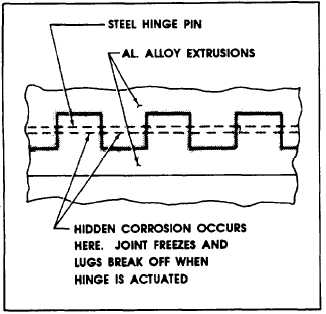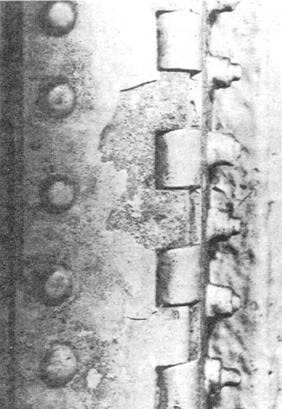205.200
Figure 4-26.—Hinge corrosion points.
structures in avionic equipment, and the skin of the
aircraft. Because of its wide use, you must be able to
recognize and take the proper corrective action
whenever corrosion is detected or suspected.
Aluminum and its alloys are subject to a wide
range of corrosive attack, varying from general
etching of the surfaces to penetrating attacks along the
internal grain boundaries of the metal. The corrosion
products (fig. 4-27) appear as white-to-gray powdery
deposits that have greater volume than the original
metal. In its early stages, aluminum corrosion is
evident as a general etching, pitting, or roughness of
the surface. The surface attack progresses quite slowly
at first; however, the attack will accelerate if the
corroding material is not given immediate attention.
Paint coatings mask evidence of corrosion, but
because the corrosion products have a greater volume,
corrosion will show up as blisters, flakes, chips, lumps,
or other irregularities in the paint coating. Often, white
or gray streaks of corrosion products become readily
apparent at breaks in the paint film. Maintenance
personnel should investigate such signs further to
determine the extent that corrosion has progressed.
There are three types of aluminum surfaces insofar
as corrosion removal is concerned. They are clad,
anodized, and exfoliated aluminum surfaces.
Clad Aluminum Surfaces. Pure aluminum has
considerable corrosion resistance compared to
aluminum alloys. but it has little or no structural
strength. An extremely thin sheet of pure aluminum
laminated onto each side of an aluminum alloy sheet
improves the corrosion resistance with little
impairment of strength. The trade name of this
aluminum laminate, as originated by the Aluminum
Company of America, is Alcad. From this trade name
the adjective clad and the verb cladding have been
derived. An example of clad aluminum is the surface
of unpainted aircraft. Not all aircraft sheet aluminum
is clad, especially those alloy sheets from which small
brackets, gussets, and fittings are made. The pure
aluminum is very soft, and fabrication processes
would severely damage or destroy the clad surfaces.
To remove corrosion from clad surfaces, the
corroded areas should be hand polished with
MIL-P-6888 metal polish. It effectively removes
stains and produces a high-gloss, lasting polish on
unpainted clad surfaces. During the polishing
operation, you should take care to avoid mechanical
4-36



